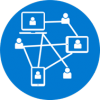Because the Internet is no longer dependent on the good old home computer, rooted and secluded, we are now facing a new need, mobile literacy. It is a macro-literacy, because the user has to be print and multimedia literate, as well as information (see information literacy and search literacy) and network literate.
Everyday objects and devices can now be smart, even houses, letting you know if your fridge has been left open or allowing you to turn on your coffee machine from your bed. More and more house thermostats will give you the opportunity to choose from work how warm your house or apartment will be when you go home, by using your phone or any internet enabled technology. But beside all this, more and more smartphones, tablets, phablets, smartwatches, smart-bands and even smart key chains are purchased every year, connecting people and creating the internet of things (IoT).
The real world and the web overlap in other ways to, thanks to augmented reality (AR). Augmented reality allows you to use visual items of the real world as triggers to display contextual web-based information. Those real life items can be QR (Quick Response) codes, two-dimensional bar-codes or even text, pictures. By scanning them with a smart mobile device such as a smartphone or a tablet, the user is offered web-pages, media files and/or text-based information (Winter M., 2011, Scan Me: Everybody’s guide to the magical world of QR codes, Napa, CA: Westsong).
Mobile technology offers limitless opportunities for the language teacher. Walls can talk (see Chinese immersion and augmented reality below); we can learn and teach from anywhere, anytime; learners can interact, collaborate and learn together; the tension of not recalling what the teacher said evaporates: learners can access learning as many times as they want to; learners can become proactive actors in and out of the classroom; communication is enhanced: students can communicate/discuss through forums/emails, etc.
On completion of this unit, you will be able to:
- define key concepts pertaining to mobile literacy
- understand how mobile Internet can be implemented in and enhance the language class
- select resources for the classroom and design mobile literacy tasks for your students
What is mobile literacy?
Definition
Dudeney, Hockly and Pegrum (2014: 14) define mobile literacy as “the ability to navigate, interpret information from, contribute information to, and communicate through the mobile internet, including an ability to orient oneself in the space of the internet of things (where information from real-world objects is integrated into the net) and augmented reality (where web-based information is overlaid on the real world).
Useful links
- Mobile Learning for Language Learning – Trends, issues and way forward, Professor Glenn Stockwell
- How It Works: Internet of Things, IBM Think Academy
- Breaking down the classroom walls: Augmented Reality and language learning, LLAS, Billy Brick and Tiziana Cervi-Wilson, University of Coventry
- Augmented Reality Enhanced Materials Design for Language Learning – Layar, Eric Hawkinson
- Chinese Immersion and Augmented Reality, AVENUESdotORG
What’s next
Visual media and multimedia literacy
Source/attribution: Digilanguages Author: Alexandre Jacquot
A lire
- 10 raisons d’utiliser les téléphones mobiles en classe, École Branchée
- Comment utiliser les portables en classe de fle, Rita Divéki
- Le jour où j’ai autorisé le téléphone portable en cours…, Arnaud Durand
A voir
- BYOD : utiliser smartphone et réalité augmentée en cours d’anglais, VousNousIls
- Ma tablette, c’est mon cartable… ou presque !, CANOPÉ Académie de Caen
Zum Weiterlesen
Qui trovi materiale italiano sull’alfabetizzazione mobile
Da vedere:
- Gilda TV, la TV degli insegnanti ha postato un video intervista sulla didattica con lo Smartphone
- Ancora Gilda TV ci offre un servizio sulle scuole che utilizzano lo Smartphone per preparare dei booktrailer
- Alberto de Panfilis, di MetaDidattica, ci parla di come usare lo Smartphone in classe
Da leggere:
- Nel blog L’italiano in azione di Casa delle lingue troviamo un post sull’uso dello Smartphone nella classe di lingua, con risorse multimediali
- In questo blog dell’Università di Padova si legge della realtà aumentata

